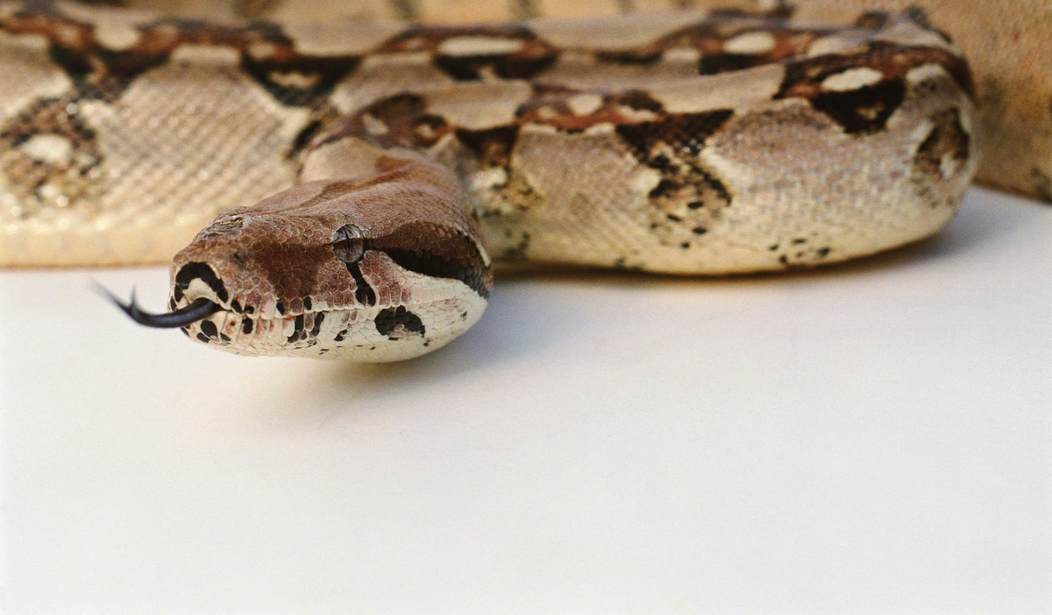Ohio firefighters and police were sent to a snake collector’s home when her newly acquired five-and-a-half-foot boa constrictor bit her face after wrapping itself around her neck. The rescue team arrived minutes later to find the woman sprawled on her blood-soaked driveway with the powerful reptile still latched onto her nose. Firefighters were able to save her by cutting the boa’s head off with a pocket knife, and the unnamed woman was taken to the hospital for her non-life threatening injuries.
This sort of encounter isn’t as uncommon as you might think due to the popularity of large constrictors in the United States; at least 17 people have been killed by various pythons since 1978. It might seem cool to own a snake that can consume a pig in one continuous gulp, but most potential owners aren’t equipped to keep an enormous and dangerous animal with a twenty- to thirty-year lifespan. The snake lady from Ohio had two boa constrictors and nine ball pythons at the time of the incident, and while I don’t know how she kept her snakes, I’m willing to bet that they weren’t kept in huge zoo-grade enclosures that are suitable for boas that can easily grow up to 13 feet long and weigh more than 100 pounds. As dangerous as constrictors are, I find it pitiful to see a mammoth python crammed into a glass case that is far too small for it…
In 2015, the U.S. Fish and Wildlife Service banned reticulated pythons, DeSchauensee’s anacondas, green anacondas, and Beni anacondas from being imported to the United States or being sold across state lines under the Lacey Act. This was done less because these snakes are particularly dangerous, but due to fears of how they would disrupt local ecosystems if they were to establish breeding populations. Other banned constrictor snakes that are labeled as “injurious” include Burmese pythons, yellow anacondas, and northern and southern African pythons. Boa constrictors were planned to be included in the snake ban, but they were delisted as reptile enthusiasts and snake breeders pressured the agency to pardon the exotic pet from the new law. Would banning boas have saved the Ohio snake adopter’s face? Probably not.
Boa constrictors are native to South and Central America and have been extremely popular pets for decades, which has led to hundreds of thousands of snakes being imported to satisfy the demand. Most boa constrictors found in the U.S. these days, however, were hatched in captivity. Boas hunt by securely grabbing prey with their razor-sharp hooked teeth so they can coil their muscular body around their target and squeeze until the unfortunate creature suffocates. Monkeys, birds, and wild pigs are common prey for wild boa constrictors, but pet boas are often fed a diet of rodents.
Maybe boa constrictors should’ve been added to the Lacey Act’s snake ban list, as breeding populations have taken hold in Puerto Rico and South Florida. These invasive pythons, which were likely dumped by careless snake breeders or pet owners, have no natural predators in their new environment, and they end up edging out local predators that are competing for the same prey. More importantly, it would be a tragedy if an introduced boa constrictor grabbed a small child or family pet because the family wasn’t expecting a 10-foot long snake to appear in their back yard.
Violent and sometimes deadly constrictor encounters happen all too often. The Humane Society has a lengthy listing of many horrible python-related incidents that have occurred in the U.S. over the years:
October 21, 2008/Virginia Beach, Virginia: A 25-year-old woman was strangled to death by her 13-foot pet reticulated python, apparently when she was attempting to administer medication to the animal.
July 1, 2009/Sumter County, Florida: A 2-year-old girl was killed in her crib by an 8½-foot Burmese python who escaped from an enclosure in her home. Weighing only 13 pounds, the snake was determined to be severely underweight. The snake had been purchased seven years earlier at a flea market. The child’s mother and her boyfriend were convicted of third degree murder, manslaughter and child neglect and sentenced to 12 years in prison.
December 16, 2006/Camp Dennison, Ohio: A 48-year-old man was strangled to death by his pet 14-foot Burmese python. When the victim reached to pick the snake up, the animal coiled around his neck and would not let go. It took three paramedics to get the snake off of the man.
August 29, 1999/Centralia, Illinois: A couple’s 1-year-old, 7½-foot African rock python escaped from an enclosure and killed their 3-year-old son while he was sleeping. They had obtained the snake three months earlier.
September 4, 2006/Lanesville, Indiana: A 23-year-old man with experience handling reptiles was killed by his 14-foot reticulated python. A medical examiner determined that the death was consistent with asphyxiation caused by compression of the neck and chest.
February 10, 2002/Aurora, Colorado: A 43-year-old man was strangled to death by his 10-foot, 80-pound pet Burmese python. Several emergency responders were required to free the man from the snake’s grip. The snake was later euthanized.
April 27, 1983/St. Louis County, Missouri: A 42-year-old man was crushed to death by his 16-foot, 100-pound pet Burmese python. His body was found by his wife and the snake was located near the body under a bed.
September 19, 1978/Florence, Kentucky: A 33-year-old reptile collector was strangled to death by one of three reticulated pythons, measuring 12, 14, and 16 feet, he kept in his basement. He was found by his wife lying on the steps with a snake wrapped around his neck.
July 20, 1993/Commerce City, Colorado: A 15-year-old was killed by his brother’s 11½-foot pet Burmese python. He had snake bites on his body, and an autopsy found he was suffocated. The 8-year-old snake had been a family pet since she was only a foot long.
August 6, 1984/Ottumwa, Iowa: An 11-month-old boy was killed in his crib by his father’s 10-foot pet reticulated python who escaped from a cage. An autopsy revealed numerous bite marks on the infant’s face, shoulder, hands, and arms and evidence of asphyxiation. The snake, determined to be emaciated, was captured and euthanized.
August 1982/Reno, Nevada: An 8-foot reticulated python escaped from his cage, crawled into an adjoining bedroom, and killed a 21-month old boy in his crib. The snake belonged to an unrelated man who lived in the house.
If you’ve read through all of those horror stories and still want to adopt a cuddly boa constrictor, I’d recommend that you do so soon; I wouldn’t be surprised if they joined their reptilian relatives in an updated draft of the Lacey Act before too long.









Join the conversation as a VIP Member